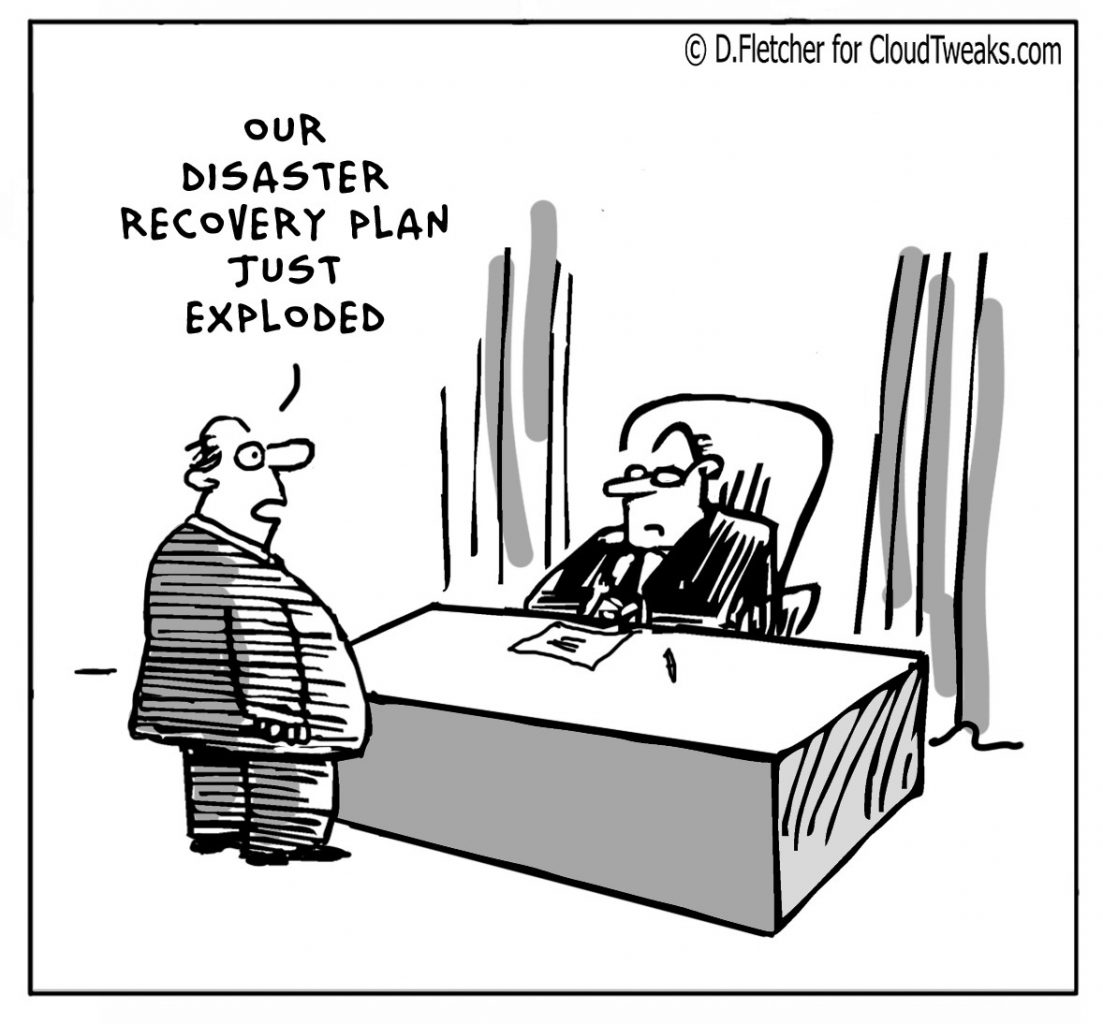May 13, 2021 by Siobhan Climer
This article was originally published in February 2019.
Congratulations! You’ve just finalized your backup and disaster recovery plan, ensured every step was tested and validated, and created SOPs so that when a disaster strikes, everything will be sorted without a hitch. Great work! You’re done, right?
Ah, if only strategic initiatives were a one-and-done event; alas, disaster recovery is never a set and forget action item. On the contrary, setting up protocols for reviewing and updating your disaster recovery plan is essential to ensure business continuity should the worst occur.
Updating Your Disaster Recovery Plan: A How-To Guide
Every environment is unique, and the policies around and within your disaster recover strategy are no different. Internal and external factors – staff changes, site additions, or software releases – change the fabric of your response protocols, and your disaster recovery plan needs to change with them. Updating your disaster recovery plan does not have to encompass an entire restructuring of your process. 2020 alone saw a dramatic shift in how we work, and where and how we back-up our data. In fact, by following the tips below, you can minimize the magnitude of plan updates and ensure business continuity.
Tip 1: Set A Review Schedule
 The best first step to updating your disaster recovery plan is to plan for it. Depending on the nature of your environment, you may need to perform a disaster recovery review every few weeks, once a quarter, or once a year. As cyberthreats become more sophisticated, many regulatory bodies require proof of regular testing as well. Aim to review more frequently than you expect and then adjust as needed. Workforce optimization tools make this easy.
The best first step to updating your disaster recovery plan is to plan for it. Depending on the nature of your environment, you may need to perform a disaster recovery review every few weeks, once a quarter, or once a year. As cyberthreats become more sophisticated, many regulatory bodies require proof of regular testing as well. Aim to review more frequently than you expect and then adjust as needed. Workforce optimization tools make this easy.
Many businesses find it beneficial to schedule disaster recovery reviews once a year – perhaps during a slower month – and review as needed throughout the rest of the year should environmental factors induce a change. However often your team chooses to review your disaster recovery plan, make sure they do it. Failing to update your disaster recovery plan is almost as bad as not having one.
Tip 2: Review Change Factors
Changes within your organization are often the most likely to affect your disaster recovery plan. These factors may come from within your organization or outside it. As you prepare to review your disaster recovery plan as an organization, review change factors that may impact your current disaster recovery strategy.
- Hardware/Software Updates
- Legacy Applications
- Staffing Changes
- Down-structuring
- New Facilities/Sites
- Regulatory Changes
- Policy Adoption
- Vendor Partnerships
- Technological Innovations
- New Vulnerabilities
- New Solutions
- Outsourced DR Site
- Increase in remote workforce
Backups are an essential part of a secure disaster recovery strategy. Find out more about modern backup solutions with our recent paper Moving Away From Tape: Strategies For Advancing To A More Modern Backup Solution.
Tip 3: Analyze Incident Data
Updating your disaster recovery plan can also be based on your organization’s experiences. The risks and threats your business faces change, and sometimes – no matter how much we prepare for them – those disasters strike. These calamities could be simply viewed as a failure; however, it is better to analyze these incidents and learn from them.
Did your data center have a ventilation issue that led to overheating? Was network security compromised through poor BYOD policies? Have a few team members that always seem to click on a phishing link? Whatever incidents occurred throughout the previous year should inform your disaster recovery review, providing insight into ways to improve your disaster recovery strategy.
Tip 4: Partner With Experts
Every review should look at the ROI for disaster recovery plan implementation. The investment your business makes – through time, headcount, application, risk, and visibility – should inform your future plans. A possible outcome of a disaster recovery review is the realization that ensuring business continuity for your organization is something best left to experts. A partner will ensure that your plan views disaster recovery as a holistic solution, not just a patchwork of point solutions.
Investing in a partnership with disaster recovery experts also allows you to focus the IT team on more strategic initiatives within the department. Plus, a partner can take the lead on updating your disaster recovery plan in the future, so you can almost set and forget it.
Tip 5: Share It
The work that goes into updating your disaster recovery plan is important, and ensuring all parties are privy to that plan is a vital last step. If the right people are ready to enact the plan in a disaster, the plan does no good. Ensure the plan is dispersed appropriately within your organization and all entities are aware of the plan framework.
It goes without saying that storing your disaster recovery plan on a single server – where it could be compromised in the event of a disaster – is a bad idea. Ensure the plan is backed up and duplicated.
Updating Your Disaster Recovery Plan Shouldn’t Be A Disaster
Periodically reviewing your disaster recovery plan is an important step in ensuring it continues to accurately portray your environment and respond to the risks and remediation necessary for business continuity. Mindsight’s disaster recovery experts are here to help you create, review, update, validate, and manage your disaster recovery strategy. With managed data backup and disaster recovery, you secure your plan and your business.
 Business today demands continuous application availability with an infrastructure that can both recover from disasters and scale to accommodate dynamic growth. From power outages to the harsh hand of Mother Nature, to cyberattacks, to global pandemics, it’s safe to assume your company’s resources are constantly at risk. IT is strongly tied to all business functions, so it’s extremely important to have a disaster recovery plan in place to protect your investments.
Business today demands continuous application availability with an infrastructure that can both recover from disasters and scale to accommodate dynamic growth. From power outages to the harsh hand of Mother Nature, to cyberattacks, to global pandemics, it’s safe to assume your company’s resources are constantly at risk. IT is strongly tied to all business functions, so it’s extremely important to have a disaster recovery plan in place to protect your investments.
Mindsight’s cloud and on-premise data backup and disaster recovery services help companies recover quickly and cost-effectively from any disruption. We do this by helping you create plans and strategies aligned with your business requirements. We thoroughly analyze your business processes and objectives to secure your business resiliency. Minimize your risk and protect your assets with Mindsight’s data backup planning and disaster recovery services.
Like what you read?
Join us May 18th for a Virtual Event as we discuss back-up and disaster recovery.
About Mindsight
Mindsight, a Chicago IT services provider, is an extension of your team. Our culture is built on transparency and trust, and our team is made up of extraordinary people – the kinds of people you would hire. We have one of the largest expert-level engineering teams delivering the full spectrum of IT services and solutions, from cloud to infrastructure, collaboration to contact center. Our highly-certified engineers and process-oriented excellence have certainly been key to our success. But what really sets us apart is our straightforward and honest approach to every conversation, whether it is for an emerging business or global enterprise. Our customers rely on our thought leadership, responsiveness, and dedication to solving their toughest technology challenges.
Contact us at GoMindsight.com.
About The Author
Siobhan Climer, Science and Technology Writer for Mindsight, writes about technology trends in education, healthcare, and business. She previously taught STEM programs in elementary classrooms and museums, and writes extensively about cybersecurity, disaster recovery, cloud services, backups, data storage, network infrastructure, and the contact center. When she’s not writing tech, she’s writing fantasy, gardening, and exploring the world with her twin two-year old daughters. Find her on twitter @techtalksio.







